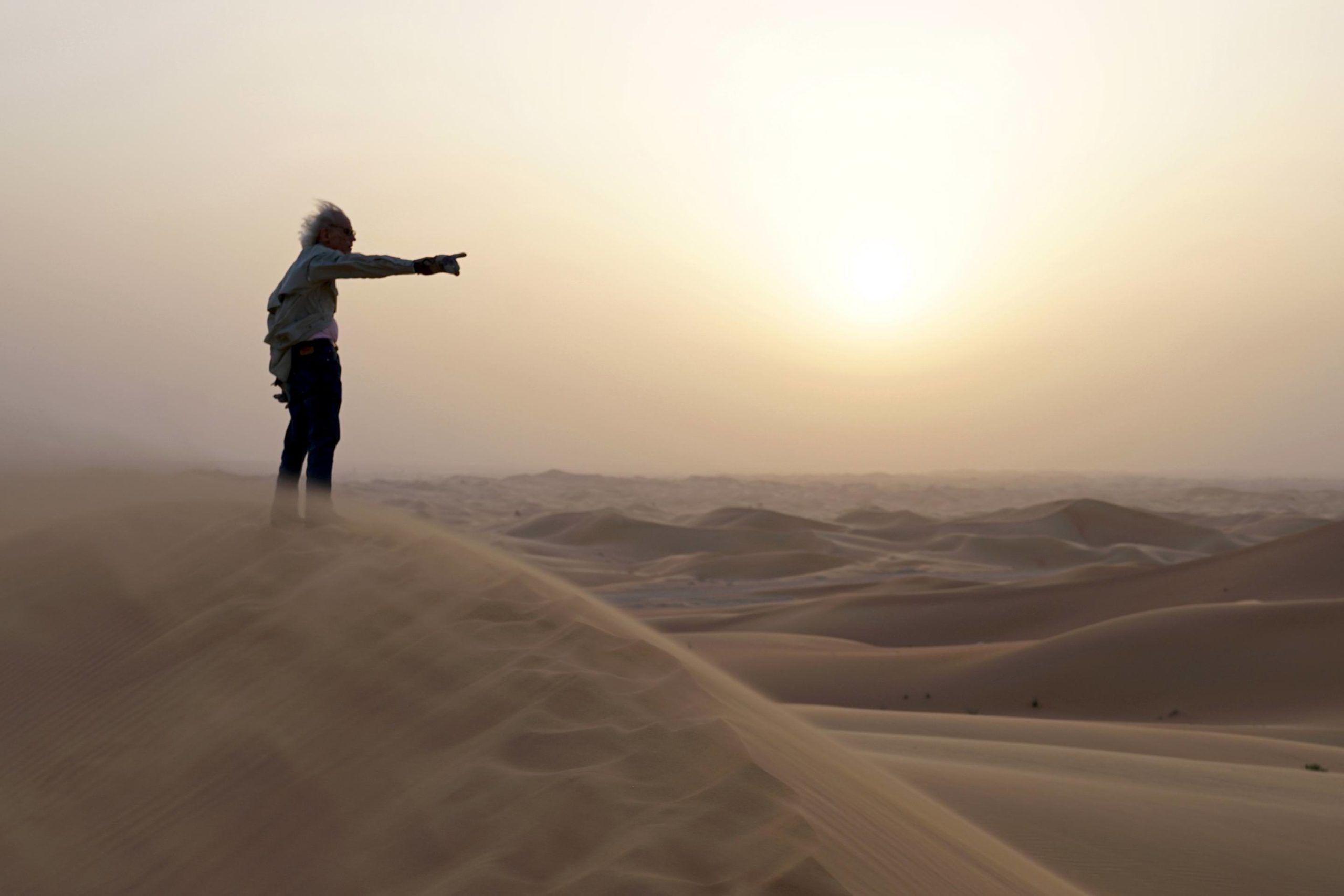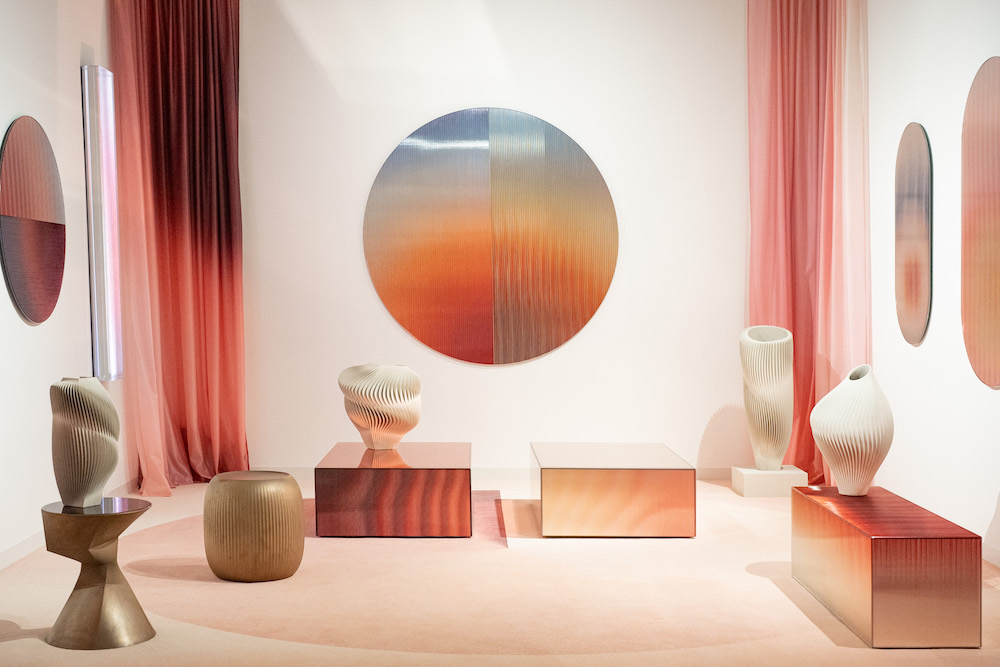Artists Christo and Jeanne-Claude—recognized by first name only—have created several magical moments in very public spaces. In Central Park, it was The Gates. In Japan and California, it was The Umbrellas. They’ve covered trees in Switzerland and buildings in Berlin, hung a curtain in a valley, and created a pier in Venice for the public to literally walk on water.
Their most recently realized project (Jeanne-Claude passed in 2009), The London Mastaba, a giant floating sculpture made of barrels, was installed over the summer at Serpentine Lake in London.
Yards upon yards of colored fabric are used to transform a site—urban or rural—and challenge our perceptions. That’s the thrill of the work, Christo told us, when we spoke with him early last fall. The variety of reactions is the most important part.
His practice with Jeanne-Claude has been more like that of an architectural firm, given how many installations and ideas go unrealized. Projects are dreamed up, sketched, and experimented with in scale models. Permissions are requested, engineers are consulted with, and not until bureaucratic hoops are properly hopped through does something come to fruition. Sometimes this takes 20 years, 40 years, sometimes less.
Fueling it all is the art of Christo, which is sold to pay for everything else. This is an important point of pride and distinction for the artist. They never worked from grants, commissions, or investors. It’s all financially backed by the sale of Christo’s drawings, sculptures, scale models, and more.
Just how much goes into one of their installations, which rarely last for more than a few days or weeks, is examined in “Christo and Jeanne-Claude: Surrounded Islands, Biscayne Bay, Greater Miami, Florida, 1980–83 | A Documentary Exhibition” at Pérez Art Museum Miami (PAMM) (on view through February 17, 2019), through the lens of one that debuted 35 years ago. The exhibition tells the story of Surrounded Islands from 1983 in Miami’s Biscayne Bay through archival documentation, objects, drawings, models, and a film. For this work, which took place for just two weeks that May, Christo and Jeanne-Claude encircled 11 islands in the bay with 6.5 million square feet of pink fabric.
Weeks before that opening, Christo shared with us the story of Surrounded Islands, the incredible process behind it all, and the permanent monument The Mastaba, which he and Jeanne-Claude planned for decades.
WHITEWALL: What goes into a project like Surrounded Islands, the subject of the exhibition at PAMM?
CHRISTO: I make contemporary works of art that stay for two weeks or three weeks, but after that, everything is removed, materials are recycled. To get permission for the project takes many years, and making the work is a very long process. Each is unique—we don’t do the same thing ever again. It costs money, and the money comes from the sale of original works of art that I make with my own hands.
There are architectural sketches, scale models. I do many of them, sometimes less if the project takes a short time to realize. The Gates in Central Park took 20 years, so there are many sketches and drawings.
When the project is removed, we collect the real components—the cables, anchors, fabric, documentation, drawings, scale models, photographs. The exhibition is a total view of the project, from the inspiration to the realization.
It is a great pleasure to bring the Surrounded Islands exhibition to the United States. This is something nobody ever saw in the United States. The exhibition is really telling the story of the project.
WW: What was the inspiration for Surrounded Islands?
C: The idea for Surrounded Islands, like all our ideas, comes from many, many things. We are fascinated, Jeanne-Claude and myself, with where water meets earth. In 1974, we did a small project in Newport, Rhode Island, called Ocean Front. We covered a little bay with fabric. It’s a little less known, but this is the earliest of the large Surrounded Islands.
When we arrived in Florida in the late seventies, we drove around with a journalist from the Miami Herald. She was entrusted with driving us around Miami in different communities, and we were crossing the Biscayne Bay. We repeatedly asked her to cross the causeway again. She thought we would like to wrap a bridge. But no, we were looking at the islands. We wanted to surround the island with the floating fabric.
WW: Once you knew you wanted to surround the islands, how did you decide on material and color?
CHRISTO: How it will be done cannot be decided in my studio. All our projects go through a very complex period of realization. First, there are sketches and drawings and an enormous amount of professional people to help guide it into reality. How should the fabric float? How will it work with the tide of the ocean?
For all our projects, we do live site tests in a secret location on a one-to-one scale. We are not sure how to do it, so we have to test many variations. There is not something in a book on how to make Surrounded Islands. We worked with engineering specialists, marine specialists, and this is why I remember it vividly.
We use industrial textile from the petrochemical industry. The only artificial fiber that will float is polypropylene. Another big problem with the project is that we did it in the most southern part of the United States with enormous power of UV lights. The pink color is the most fragile color. That’s what happened in the first days of the test. In 34 hours the pink became white.
Then the only company we could find to make the fabric with the right amount of color was in Germany. German engineers were willing to research and make a fabric that stayed totally pink for at least most of 14 days.
Then it was very difficult to sew the fabric. Our engineers decided to build our own sewing setup in a huge loft building. We built railroad tracks on which the sewing machine moved. We did not move the fabric. The sewing machine was moving and the fabric laid on the floor.
WW: How did you then get the fabric to float around the islands?
C: The fabric was sewn into sections for all 11 islands, and later connected by humans in the water. To keep that shape, our marine engineer made a complex system of white nylon ropes floating under the pink fabric like bicycle spokes to keep the shape of the fabric exactly in the form of the island. And a special system was created to compensate for the changing of the tide of the water.
WW: Tell us about your plan for The Mastaba, a massive permanent sculpture you started planning in 1977. It is now imagined for Abu Dhabi, made up for 410,000 multicolored barrels. It’s similar in shape to The London Mastaba that floated this summer in the Serpentine Lake.
C: The floating Mastaba I tried to do in Lake Michigan in 1967. And it never happened. Now we have to get permission for this project in the Middle East, and it is very complex. The idea of the floating Mastaba was to build a structure that can convey the magnitude of the project in Abu Dhabi, much smaller in scale but in the same proportion. Building that project in London in the summertime, when most of the wealthy people of the Middle East live there, so they saw the real proportions of The Mastaba. They had to see it for themselves.
WW: You’ve said that the beauty of your work is in the unplanned reaction. Do you remember any of the surprising reactions from a finally realized project that surprised you?
C: We are continually surprised, because we discover many things even after the project is removed. The Umbrellas project was a work of art in two parts, like a diptych. To landscapes, in the U.S. and Japan, The Umbrellas were like a roof to a house without walls. They were 30 feet tall, like two-story houses. At the base of the umbrella was a very large platform designed for people to sit under and picnic.
People in California put out blankets and were sitting and picnicking. Japanese people did the same thing, but in Japan you do not walk on the floor of the house. So they removed their shoes and walked barefoot on the base of the umbrella. It was like the floor of the house for them.
We only discover the project when, finally, it is built. This is why we always do new things. People are very attracted to something that’s once in a lifetime. Few things are left like that in the world. The project builds its own reality for several days or weeks. It creates some point of view for so many people. Each point of view is legitimate.









